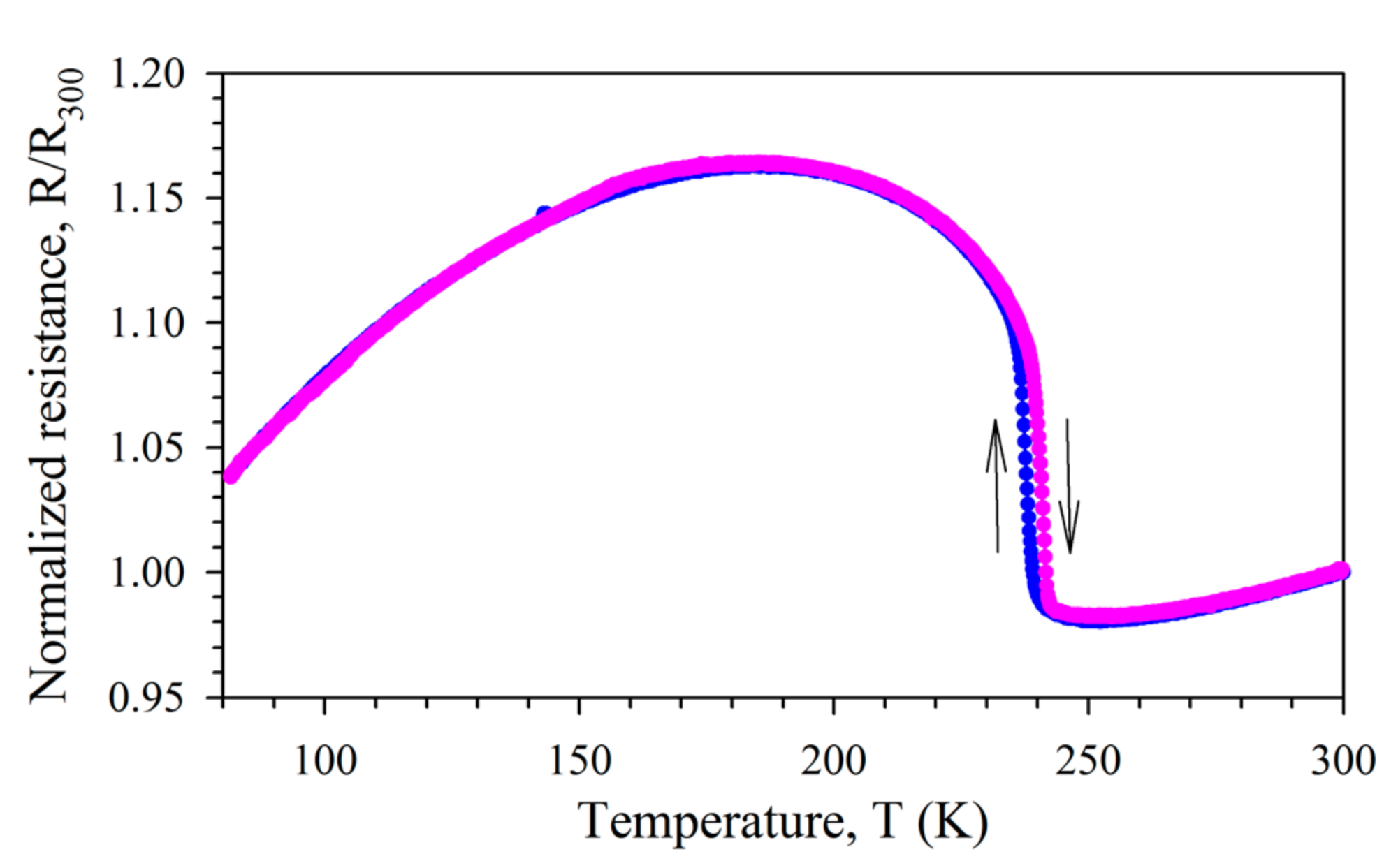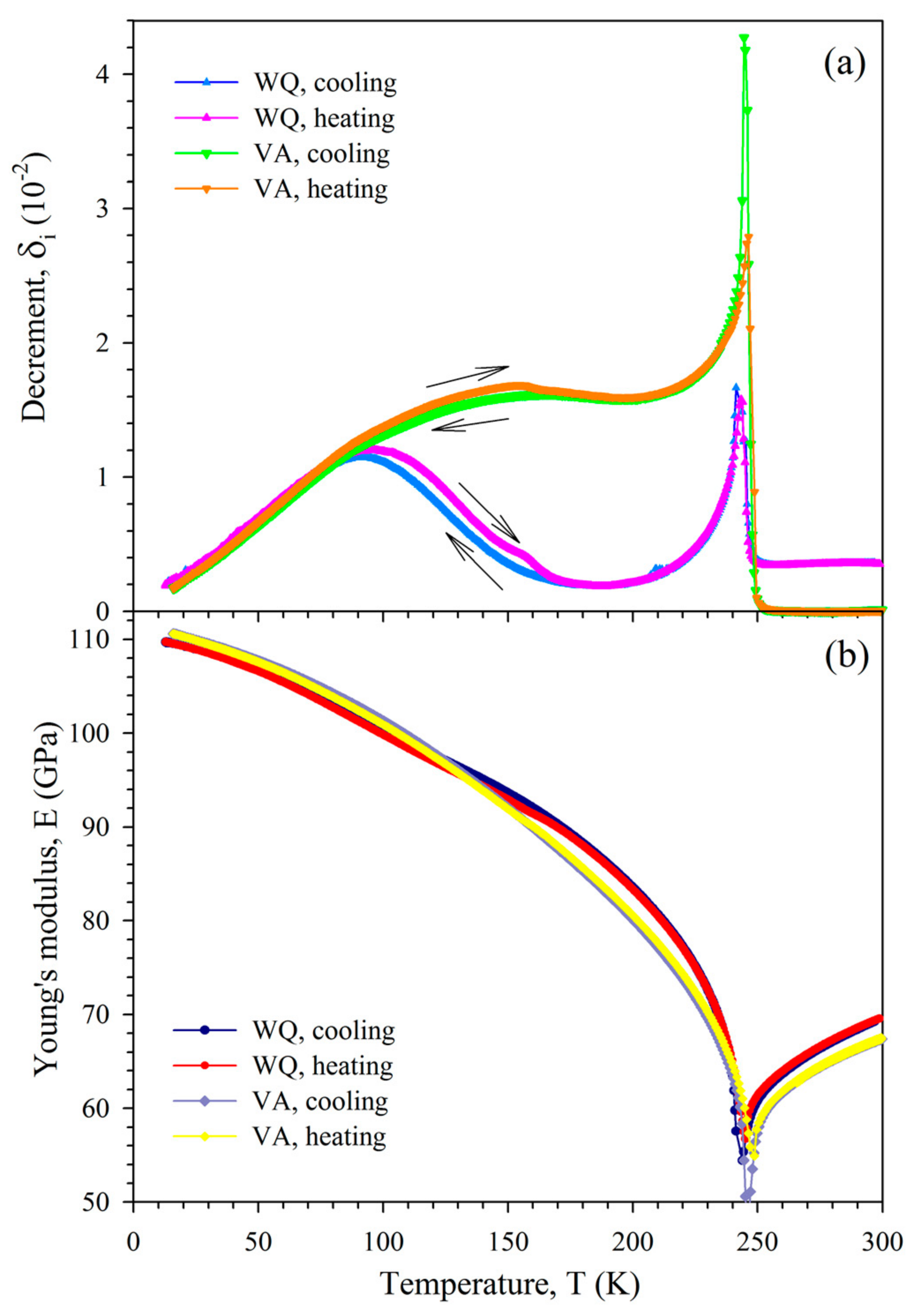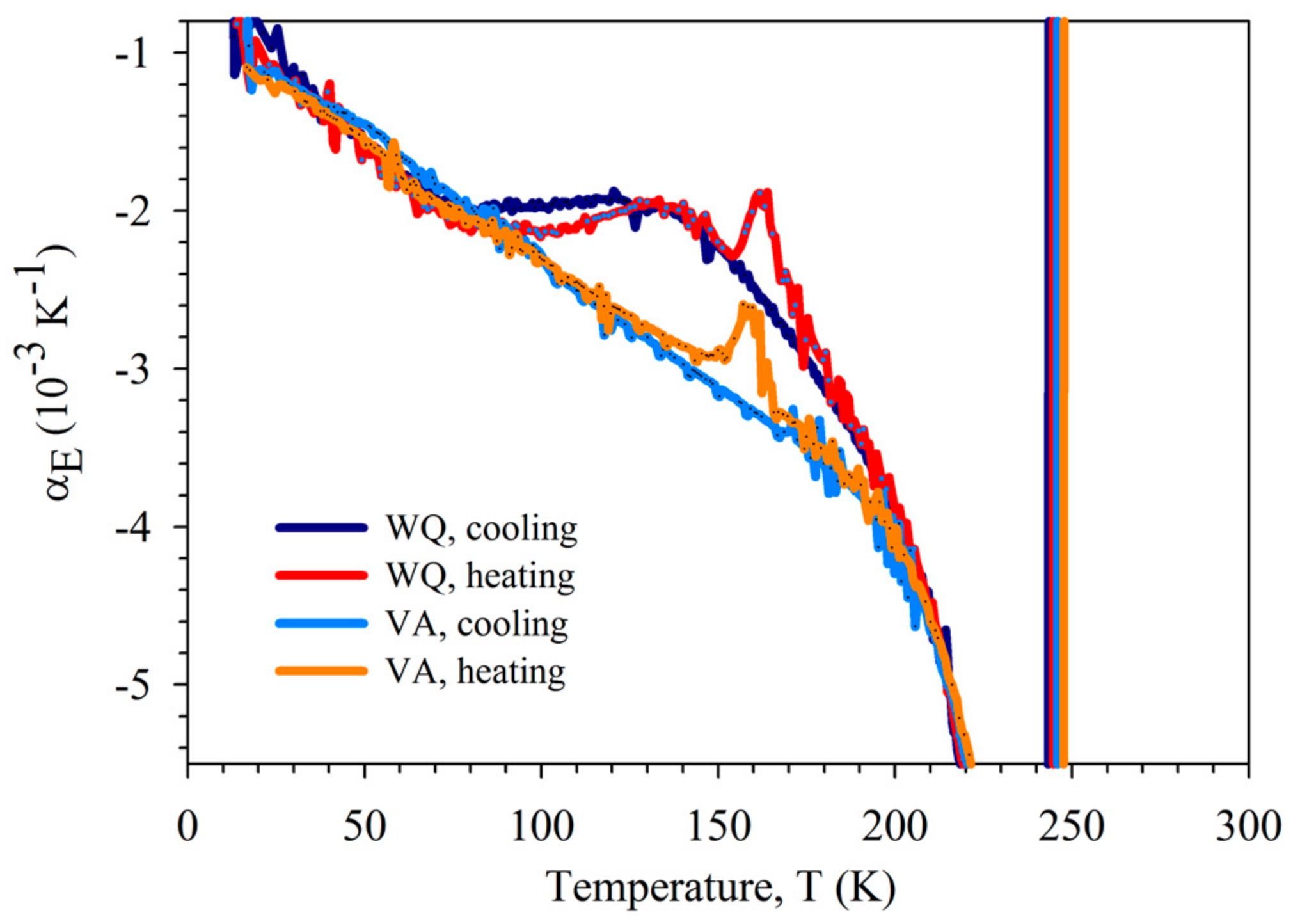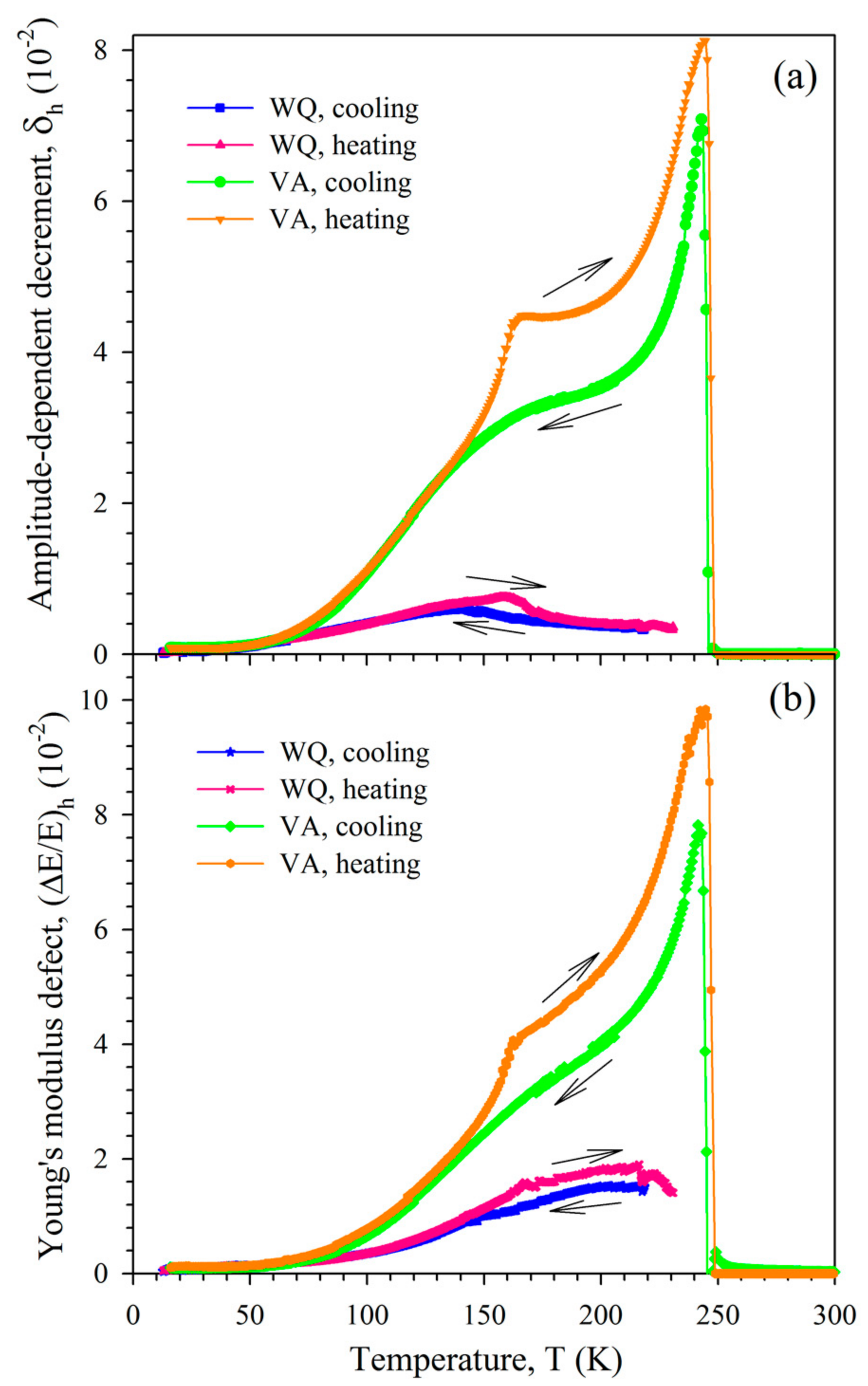Effect of Hydrogen on the Elastic and Anelastic Properties of the R Phase in Ti50Ni46.1Fe3.9 Alloy
Abstract
:1. Introduction
2. Materials and Methods
3. Results
4. Discussion
5. Conclusions
- (1)
- Contamination of the Ti50Ni46.1Fe3.9 alloy by hydrogen gives rise to an IF maximum in the R martensitic phase and a complicated pinning stage in the temperature dependence of the effective Young’s modulus at temperatures corresponding to the high-temperature side of the IF maximum.
- (2)
- Dehydrogenation heat treatment of the H-contaminated Ti50Ni46.1Fe3.9 alloy transforms the IF maximum into a plateau or a smooth maximum caused by a residual hydrogen content.
- (3)
- The IF maximum is associated with a competition of two different temperature-dependent processes affecting the hydrogen concentration in the core regions of twin boundaries, similarly to the non-relaxation IF maximum observed earlier in the B19′ martensitic phase of a Ni50.8Ti49.2 alloy.
- (4)
- Amplitude-dependent anelasticity (IF and Young’s modulus defect) of the R phase is also very sensitive to hydrogen content, but its maximum values are shifted to higher temperatures as compared to those of the amplitude-independent IF. The temperature dependence of the amplitude-dependent anelasticity is associated with evolution of extended hydrogen atmospheres near twin boundaries.
- (5)
- Diffusion mobility of hydrogen interstitials in the R phase is lower than in the B19’ phase.
Acknowledgments
Author Contributions
Conflicts of Interest
References
- Otsuka, K.; Ren, X. Physical metallurgy of Ti-Ni-based shape memory alloys. Prog. Mater. Sci. 2005, 50, 511–678. [Google Scholar] [CrossRef]
- Blanter, M.S.; Golovin, I.S.; Neuhäuser, H.; Sinning, H.-R. Internal Friction in Metallic Materials. A Handbook; Springer: Berlin/Heidelberg, Germany, 2007. [Google Scholar]
- Mazzolai, G. Recent progresses in the understanding of the elastic and anelastic properties of H-free, H-doped and H-contaminated NiTi based alloys. AIP Adva. 2011, 1, 040701. [Google Scholar] [CrossRef]
- Fan, G.; Zhou, Y.; Otsuka, K.; Ren, X.; Nakamura, K.; Ohba, T.; Suzuki, T.; Yoshida, I.; Yin, F. Effects of frequency, composition, hydrogen and twin boundary density on the internal friction of Ti50Ni50−xCux shape memory alloys. Acta Mater. 2006, 54, 5221–5229. [Google Scholar] [CrossRef]
- Fan, G.; Otsuka, K.; Ren, X.; Yin, F. Twofold role of dislocations in the relaxation behavior of Ti-Ni martensite. Acta Mater. 2008, 56, 632–641. [Google Scholar] [CrossRef]
- Sapozhnikov, K.; Torrens-Serra, J.; Cesari, E.; Van Humbeeck, J.; Kustov, S. On the effect of hydrogen on the low-temperature elastic and anelastic properties of Ni-Ti-based alloys. Materials 2017, 10, 1174. [Google Scholar] [CrossRef] [PubMed]
- Zhang, J.; Wang, Y.; Ding, X.; Zhang, Z.; Zhou, Y.; Ren, X.; Wang, D.; Ji, Y.; Song, M.; Otsuka, K.; et al. Spontaneous strain glass to martensite transition in a Ti50Ni44.5Fe5.5 strain glass. Phys. Rev. B 2011, 84, 214201. [Google Scholar] [CrossRef]
- Chui, N.Y.; Huang, Y.T. A study of internal friction, electric resistance and shape change in a Ti-Ni-Fe alloy during phase transformation. Scr. Mater. 1987, 21, 447–452. [Google Scholar] [CrossRef]
- Fan, G.; Zhou, Y.; Otsuka, K.; Ren, X. Ultrahigh damping in R-phase state of Ti–Ni–Fe alloy. Appl. Phys. Lett. 2006, 89, 161902. [Google Scholar] [CrossRef]
- Yoshida, I.; Monma, D.; Ono, T. Damping characteristics of Ti50Ni47Fe3 alloy. J. Alloys Compd. 2008, 448, 349–354. [Google Scholar] [CrossRef]
- Fan, G.; Zhou, Y.; Otsuka, K.; Ren, X. Comparison of the two relaxation peaks in the Ti50Ni48Fe2 alloy. Mater. Sci. Eng. A 2009, 521–522, 178–181. [Google Scholar] [CrossRef]
- Wang, D.; Zhang, Z.; Zhang, J.; Zhou, Y.; Wang, Y.; Ding, X.; Wang, Y.; Ren, X. Strain glass in Fe-doped Ti–Ni. Acta Mater. 2010, 58, 6206–6215. [Google Scholar] [CrossRef]
- Zuo, S.; Jin, M.; Chen, D.; Jin, X. Origin of the anelastic behavior in Ti50Ni44Fe6 alloy. Scr. Mater. 2015, 108, 113–116. [Google Scholar] [CrossRef]
- Chang, S.H.; Chien, C.; Wu, S.K. Damping characteristics of the inherent and intrinsic internal friction of Ti50Ni50−xFex (x = 2, 3, and 4) shape memory alloys. Mater. Trans. 2016, 57, 351–356. [Google Scholar] [CrossRef]
- Zhang, J.; Xue, D.; Cai, X.; Ding, X.; Ren, X.; Sun, J. Dislocation induced strain glass in Ti50Ni45Fe5 alloy. Acta Mater. 2016, 120, 130–137. [Google Scholar] [CrossRef]
- Yokoyama, K.; Tomita, M.; Sakai, J. Hydrogen embrittlement behavior induced by dynamic martensite transformation of Ni-Ti superelastic alloy. Acta Mater. 2009, 57, 1875–1885. [Google Scholar] [CrossRef]
- Saito, T.; Yokoyama, T.; Takasaki, A. Hydrogenation of TiNi shape memory alloy produced by mechanical alloying. J. Alloys Compd. 2011, 509 (Suppl. 2), S779–S781. [Google Scholar] [CrossRef]
- Ribeiro, R.M.; Lemus, L.F.; dos Santos, D.S. Hydrogen absorption study of Ti-based alloys performed by melt-spinning. Mater. Res. 2013, 16, 679–682. [Google Scholar] [CrossRef]
- Robinson, W.H.; Edgar, A. The piezoelectric method of determining mechanical damping at frequencies of 30 to 200 kHz. IEEE Trans. Sonics Ultrason. 1974, 21, 98–105. [Google Scholar] [CrossRef]
- Kustov, S.; Golyandin, S.; Ichino, A.; Gremaud, G. A new design of automated piezoelectric composite oscillator technique. Mater. Sci. Eng. A 2006, 442, 532–537. [Google Scholar] [CrossRef]
- Polyanskiy, A.M.; Polyanskiy, V.A.; Yakovlev, Y.A. Experimental determination of parameters of multichannel hydrogen diffusion in solid probe. Int. J. Hydrogen Energy 2014, 39, 17381–17390. [Google Scholar] [CrossRef]
- Choi, M.S.; Fukuda, T.; Kakeshita, T. Anomalies in resistivity, magnetic susceptibility and specific heat in iron-doped Ti-Ni shape memory alloys. Scr. Mater. 2005, 53, 869–873. [Google Scholar] [CrossRef]
- So, K.H.; Kim, J.S.; Chun, Y.S.; Park, K.T.; Lee, Y.K.; Lee, C.S. Hydrogen delayed fracture properties and internal hydrogen behavior of a Fe-18Mn-1.5Al-0.6C TWIP steel. ISIJ Int. 2009, 49, 1952–1959. [Google Scholar] [CrossRef]
- Myers, S.M.; Baskes, M.I.; Birnbaum, H.K.; Corbett, J.W.; DeLeo, G.G.; Estreicher, S.K.; Haller, E.E.; Jena, P.; Johnson, N.M.; Kirchheim, R.; et al. Hydrogen interactions with defects in crystalline solids. Rev. Mod. Phys. 1992, 64, 559. [Google Scholar] [CrossRef]
- Thompson, D.O.; Pare, V.K. Effect of fast neutron bombardment at various temperatures upon the Young’s modulus and internal friction of copper. J. Appl. Phys. 1960, 31, 528–535. [Google Scholar] [CrossRef]
- Magalas, L.B.; Moser, P. Internal friction in cold worked iron. J. Phys. Coll. 1981, 42, C5-97–C5-102. [Google Scholar] [CrossRef]
- Takamura, S.; Kobiyama, M. Dislocation pinning in Al and Ag alloys after low-temperature deformation. Phys. Stat. Sol. A 1986, 95, 165–172. [Google Scholar] [CrossRef]
- Kirchheim, R. Interaction of hydrogen with dislocations in palladium—I. Activity and diffusivity and their phenomenological interpretation. Acta Metall. 1981, 29, 835–843. [Google Scholar] [CrossRef]




| Sample | Hydrogen Content, at. ppm | ||
|---|---|---|---|
| Extracted at 803 K | Extracted at 1073 K | Total | |
| WQ | 372 | 79 | 450 |
| VA | 41 | 38 | 79 |
© 2017 by the authors. Licensee MDPI, Basel, Switzerland. This article is an open access article distributed under the terms and conditions of the Creative Commons Attribution (CC BY) license (http://creativecommons.org/licenses/by/4.0/).
Share and Cite
Sapozhnikov, K.; Torrens-Serra, J.; Cesari, E.; Van Humbeeck, J.; Kustov, S. Effect of Hydrogen on the Elastic and Anelastic Properties of the R Phase in Ti50Ni46.1Fe3.9 Alloy. Metals 2017, 7, 493. https://doi.org/10.3390/met7110493
Sapozhnikov K, Torrens-Serra J, Cesari E, Van Humbeeck J, Kustov S. Effect of Hydrogen on the Elastic and Anelastic Properties of the R Phase in Ti50Ni46.1Fe3.9 Alloy. Metals. 2017; 7(11):493. https://doi.org/10.3390/met7110493
Chicago/Turabian StyleSapozhnikov, Konstantin, Joan Torrens-Serra, Eduard Cesari, Jan Van Humbeeck, and Sergey Kustov. 2017. "Effect of Hydrogen on the Elastic and Anelastic Properties of the R Phase in Ti50Ni46.1Fe3.9 Alloy" Metals 7, no. 11: 493. https://doi.org/10.3390/met7110493





